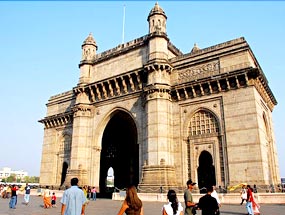Gateway of India is one of the most prized
monuments of the Mumbai City. Read about Gateway of India in Bombay,
Maharashtra.
Gateway of India

Location: Mumbai, Maharashtra
Founded By: Sir George Sydenham Clarke
Founded In: 1920-1924
Architect: George Wittet
Gateway of India is one of the major landmarks of India, situated in
the Mumbai city of Maharashtra. The moment a visitor/tourist arrives in
Mumbai by a boat, the first sight that comes in view is that of the
massive Gateway of India. As you cross the gateway and move on to the
steps behind it, the waterfront of the South Mumbai looms in view. From
there, you can take boat trips to various locations, like the Elephanta
Island. The monument is basically a 26 meters high arch, which has been
made out of yellow basalt and reinforced concrete.
The architecture of the gateway is mainly based on the Indo-Saracenic
style. However, elements from the Muslim architectural styles of 16th
century Gujarat can also be seen. The central dome of the Gateway of
India, standing at a height of 26 m, has a diameter of fifteen meters.
When the gateway was constructed, the whole of the harbor front had to
be realigned. This was done in order to make it fall in line with a
planned esplanade, which was to sweep down to the center of the Bombay
city.
Even in the early 20th century, the construction cost of Gateway of
India came to somewhere around Rs. 21 lakhs. The cost was mainly borne
by the Government of India. Since adequate funds were not available, the
plan of building an approach road could not be put into action. The main
reason for the construction of the Gateway of India was built to
commemorate the visit of King George V and Queen Mary to Bombay (now
Mumbai). The visit was made before the Darbar in Delhi that was set up
in December 1911.
The foundation stone of the monument was laid by, the then, Governor of
Bombay Sir George Sydenham Clarke on 31st March 1911. The architect of
the gateway was George Wittet, whose final design was sanctioned in
August 1914. The time period between 1915 and 1919 was spent on
reclamations at Apollo Bundar, which were done for the land on which the
gateway and the new sea wall were to be built. The foundations were
finally completed in the year 1920 and the Gateway of India was
completely ready in 1924.
Gammon India Limited, established by J C Gammon in 1919, carried out
the construction work on the foundations of the gateway. During that
time, it was the only construction company in India that was accredited
with ISO 9001: 1994 certification in all fields of civil engineering,
including design. The First Battalion of the Somerset Light Infantry,
which were the last British troops to leave India after the country
gained independence, passed through the Gateway of India in a ceremony
on 28th February 1948.


